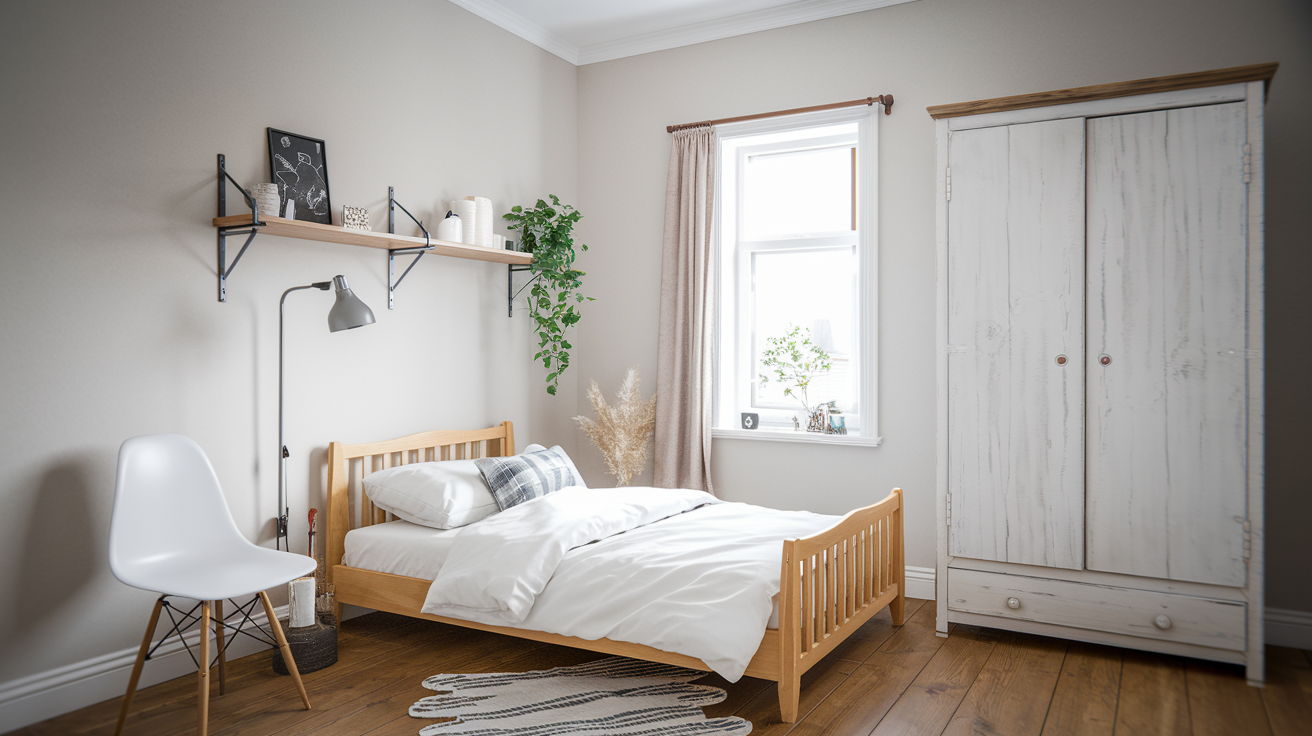I think designing a small bathroom that feels spacious, modern, and functional can be quite a challenge. However, in my opinion, with smart planning, the right choice of materials, and space-saving solutions, it’s absolutely possible to create a comfortable and practical space. I recommend focusing on maximizing storage and choosing a layout that makes the room feel open rather than cluttered.
Looking at my bathroom, I think it’s a great example of how to fit everything you need like a bathtub, a sink with a mirror, a toilet, a washing machine, and plenty of storage without making the space feel cramped.
Modern Trends Reflected in This Bathroom Design
- Neutral Color Palette with Subtle Accents

This bathroom follows one of the biggest trends of recent years – a soft, neutral base with a touch of color in the patterned tiles. Light-colored walls visually expand the space, while the muted green cabinetry and geometric floor and wall tiles add character without overwhelming the room.
2. Efficient Use of Space

Every element in this bathroom is placed thoughtfully to maximize functionality. The built-in cabinets provide ample storage for toiletries, towels, and other essentials, keeping the space clutter-free. The placement of the washing machine under the countertop is a smart solution that makes the most of vertical space.
3. Stylish and Practical Lighting

Proper lighting is essential in a compact bathroom, and this design incorporates modern pendant lights and a wall-mounted light near the mirror. These elements not only enhance the overall ambiance but also ensure sufficient illumination for daily tasks like skincare and grooming.
A Perfect Blend of Functionality and Elegance

This bathroom design successfully combines modern trends, smart storage, and stylish aesthetics to create a cozy yet practical space. The balance of light tones, geometric accents, and efficient organization makes it an excellent inspiration for anyone looking to remodel a small bathroom. Whether you’re dealing with limited space or simply want a more structured and trendy look, this layout proves that even a compact bathroom can be both functional and visually appealing.
5 Tips for Arranging Furniture and Fixtures in a Small Bathroom

Designing a small bathroom requires a strategic approach to make the most of the available space while maintaining comfort and style. Based on the layout in the photos, here are five essential tips to help you optimize your bathroom’s functionality without compromising on aesthetics.
1. Choose Built-In and Vertical Storage
In a compact bathroom, every centimeter matters. Instead of bulky freestanding furniture, opt for built-in cabinets that seamlessly blend into the walls. In this design, tall storage cabinets make use of vertical space, allowing for maximum storage without taking up too much room.
2. Position the Washing Machine Wisely
If your bathroom needs to accommodate a washing machine, placing it under a countertop near storage cabinets is a great solution. This layout keeps it integrated into the design while maintaining a clean and organized look. A countertop above the washing machine also provides a functional surface for daily use.
3. Use a Shower Curtain Instead of Glass Partitions

To visually expand the space and keep the layout open, a light and transparent shower curtain is a better option than a bulky glass shower partition. This creates an airy feel and allows easy access to the bathtub while keeping water contained.
4. Keep Plumbing Fixtures Along One Wall
A smart plumbing layout is key in a small bathroom. In this design, the bathtub, sink, and toilet are positioned along the same wall, which not only makes the space more structured but also reduces installation costs and maximizes available space.
5. Add Light and Reflective Surfaces
Mirrors, light-colored tiles, and ample lighting create the illusion of a larger, brighter space. A large mirror above the sink helps reflect light, while pendant and wall-mounted lighting ensure good illumination without taking up extra space.

By following these space-saving strategies, you can design a stylish, functional, and modern small bathroom that feels comfortable and well-organized. Whether you’re planning a renovation or a brand-new layout, clever storage, smart fixture placement, and light-enhancing elements will help you create a bathroom that looks and feels more spacious than it actually is.
Pros and Cons of a Bathroom Window: Is It Worth Including in Your Design?
A window in the bathroom is a rare feature, but if you have the opportunity to include one, it’s important to weigh the advantages and disadvantages. It can significantly enhance the functionality of the space, but it also requires special attention when it comes to privacy and maintenance.
Pros of a Bathroom Window

1. Natural Lighting
The biggest advantage of having a window is the abundance of natural light, which makes the bathroom feel more spacious, cozy, and inviting. Natural light also improves visibility, making skincare and makeup application much easier. Additionally, it helps reduce electricity usage during the day.
2. Improved Ventilation and Reduced Humidity
A window allows for natural air circulation, which is crucial in a high-moisture environment. It helps prevent foggy mirrors, condensation buildup, and mold growth. With a bathroom window, maintaining fresh air becomes much easier without relying solely on an exhaust fan.
3. A More Open and Airy Space
For small bathrooms, a window can be a game-changer. It creates the illusion of more space, making the room feel bigger and less confined. If the window has a scenic view, it can also become a focal point in the design.
4. The Possibility of Indoor Plants
Live plants in the bathroom are a major trend, but they require adequate light. A window provides the necessary conditions for moisture-loving plants such as ferns, orchids, and monstera, adding a natural and stylish touch to the space.
5. Natural Warmth and Energy Savings
A bathroom window allows sunlight to naturally warm the space, which can be particularly beneficial during colder months. If the window faces the south or west, it can help reduce heating costs by letting in extra warmth.
Cons of a Bathroom Window

1. Lack of Privacy
The most obvious downside is the potential loss of privacy. If the window faces neighboring houses or a street, you may feel uncomfortable without frosted glass or proper coverings.
2. Design Limitations
Having a window means less available wall space, making it difficult to install mirrors, cabinets, or other storage solutions. You also need to carefully choose curtains, blinds, or frosted glass to maintain a balance between light and privacy.
3. Heat Loss in Winter
If the window is not well insulated, it can become a source of drafts and heat loss during the winter. Large windows or older single-pane glass may require additional insulation or sealing to prevent this issue.
4. Maintenance and Cleaning Challenges
Since bathrooms are high-moisture areas, window glass may often fog up and accumulate water stains, requiring frequent cleaning. If the window is positioned high or in a hard-to-reach place, maintenance can become inconvenient.
5. Unwanted Noise and Smells
If your bathroom window faces a busy street or an inner courtyard, you might experience outside noise disturbing your relaxation. In some apartment buildings, windows near ventilation shafts can also allow unpleasant odors to enter the bathroom.

A bathroom window is a wonderful design feature, but it requires careful consideration regarding insulation, privacy solutions, and maintenance. If your home allows for one, it can be a great addition to improve lighting, air circulation, and overall aesthetics.



